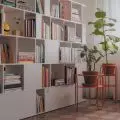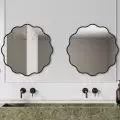Mostafa Salem 's commitment to creating spaces that combine tradition and modernity has already earned him recognition on the international scene. Salem' s work has been featured in prestigious publications such as ArchDaily, and at La Biennale di Venezia, where he served as curator of the Egyptian Pavilion. An appearance at TEDx further cemented the Egyptian architect's reputation by exposing the public to his inspiring architectural perspectives. During a conversation with the designer, whose work won in the OUTDOOR category and won second place in the main category of the Paradyż Designers Competition, we touched on his recent lectures and discussed his thoughts on the future of urban planning and the role of the architect in shaping the modern world.
During the Paradyż Designers Awards Gala, you mentioned that "Just as cuisine reflects regional identity, architecture should do the same. We build for the future, not for passing trends." Straight from Warsaw, you traveled to Paris for your original lecture: "Architecture from the Front: Lasagne is not Koshary" at the École Nationale Supérieure d'Architecture de Paris-Malaquais in the prestigious Amphithéâtre d'Honneur. What was the topic of your presentation?
- We are facing a world where "instagram" aesthetics often prevail over context and user experience. I touch quite extensively on the fact that today we often see a lack of consistency between the materials chosen and the environment in which they are used. Examples include glass facades in harsh climates or solar panels in deserts that require massive amounts of water to clean - just a few examples where aesthetics trump long-term sustainability. My presentation shed light on these issues, emphasizing the importance of understanding the long-term impact of design choices. Architects today are under pressure to create designs that look good online, neglecting the needs of the environment and the people who will inhabit those spaces. Students, caught up in the rapid development of AI and BIM tools, can fall into the belief that architecture is only about creating eye-catching visuals. Clients, bombarded with stunning images on social media, seek similar designs for their developments, overlooking key aspects such as functionality and sustainability. This trend undermines the cultural identity and environmental sensitivity that architecture should embody. My message is that as educators, we need to refocus on the basic principles of architecture with our students. Researchers also need to bridge the gap between their accomplishments and practicing architects. Together, we should educate clients about what really serves the community. Just as lasagna will never be the star of the Egyptian table, architectural trends lose their meaning when transferred from one context to another. Let's build for climate, not for passing trends!
Paradyż Designers Gala
Photo: Bartek Barczyk ©CERAMIKA PARADYŻ
What was your inspiration for the design for the international Paradyż Designers competition, and how did you use Paradyż Ceramics' TRI-D sinters for this project?
-The moment I saw the brief for the Paradyż Designers competition on Archdaily, I had a dazzling experience. Unlike typical architectural competitions, this one wasn't just about creating a building; it invited us to rediscover the potential of TRI-D quartz surfaces. This deeply appealed to me as a designer who is passionate about pushing boundaries and discovering innovative materials. This is what fascinated me the most. The competition therefore triggered a different way of thinking. This focus on materiality was the driving force behind my competition entry.
Paradyż Designers Gala
Photo: Bartek Barczyk ©CERAMIKA PARADYŻ
Can you share the experiences and challenges you encountered during the Paradyż Designers competition? What elements of your design do you think resonated most with the jury?
-It is difficult to say unequivocally what resonated with the jury, but I believe that two aspects may have caught their attention. First, the concept of using TRI-D Paradyż quartz surfaces at the bus station was unusual. This choice provided ample daily exposure for the material, providing constant and significant advertising for Paradyż. Second, I focused on tight integration of the design with the surrounding environment. This meant using TRI-D quartz sintering in a way that complimented the local aesthetic and climate, demonstrating the material's easy adaptation to different contexts. Ultimately, I am extremely grateful to the jury for recognizing the potential of my design.
Paradyż Designers Gala
Photo: Bartek Barczyk ©CERAMIKA PARADYŻ
Tell us more about your design philosophy. How does this approach influence your projects ?
-The basis is a thorough understanding of the specific context of the project. I usually study the local environment, cultural heritage and existing architectural patterns. After immersing myself in the context, I can identify traditional materials, design elements and spatial arrangements that resonate with the community. This philosophy inherently promotes sustainable and climate-resilient design. Traditional architecture often embodies a deep understanding of local resources. If we integrate these lessons with modern designs, we can create buildings that are culturally appropriate, energy efficient and resilient to environmental conditions.
Paradyż Designers Gala
Photo: Bartek Barczyk ©CERAMIKA PARADYŻ
How do you see your role as an architect in the context of contemporary urban spaces? What responsibilities do you think architects have in shaping these environments?
-The role ofthe architect should evolve into that of a responsible narrator of history and advocate for the community. This goes beyond just designing visually appealing structures. We need to be deeply involved in the context of our projects, understanding the social fabric, cultural heritage and environmental challenges of a specific location. This is, of course, consistent with the message I conveyed at my conference in Paris. Architects must move beyond the temptation of "instagram" designs and prioritize the long-term needs of the people who will inhabit these spaces. We must design for real functionality, social interaction and environmental sustainability. A building shouldn't look good just for a quick photo; it should be a place that builds a sense of belonging and serves its purpose for generations.
Your work often emphasizes the importance of cultural context in architecture. Can you tell us about a specific project where this was particularly important?
-A lighthouse project in Egypt comes to mind. Pedestrian safety is often overlooked in Egyptian cities, where existing lampposts mainly serve vehicles. To address this, we designed a lamppost with a distinct, angular shape that effectively illuminates both sidewalks and roads. This approach satisfied a functional need and fit harmoniously into the local context. Egyptian architecture has historically relied on orthogonal grids rather than curves. Respecting this, we ensured that the shape of the lighthouse remained angular, with an abstract element at the top. This element resembled the silhouette of a pharaonic reed plant, instantly recognizable to passersby and subtly referencing Egypt's rich history. The design, despite its small size, demonstrates well the importance of understanding cultural context.
Paradyż Designers Gala
Photo: Bartek Barczyk ©CERAMIKA PARADYŻ
Why do you think it is worthwhile to compete in architectural competitions? What benefits can arise from participation in such events for both young architects and experienced professionals?
- Architectural competitions have been a constant source of inspiration and development for me throughout my career, and winning the Paradyż Designers competition is my ninth. Such struggles force creative thinking in response to unique challenges, and feedback from respected jurors is invaluable for refining design approaches. Whether it's an international competition emphasizing a deep understanding of context or a local challenge, these events are a constant reminder that our work is not just about aesthetics, but about designing for real people and places. Competitions are like a training camp for architects, they keep us motivated, promote continuous learning and build a strong portfolio. That's why I've been competing in them since I was a student, and I strongly encourage everyone, especially young architects, to participate. You might be surprised what you can achieve with them.
This year's Paradyż Designers competition was a huge success, attracting many talented participants from around the world. The event brought together a variety of projects that reflected new trends and innovative approaches to working with TRI-D quartz sinters. Entries came from all corners of the globe, which further emphasized the international nature of the competition and its prestige. Thanks to the high level and creativity of the participants, the Paradyż Designers competition has become an important event in the design world, confirming its position as a platform for recognition and professional success both in Poland and around the world.
For more information: www.paradyz.com
































